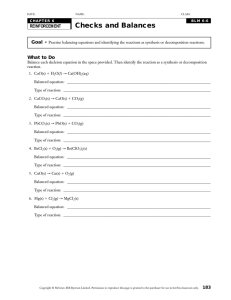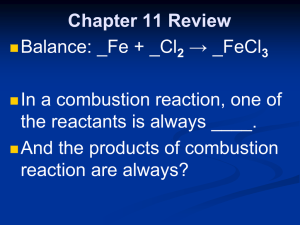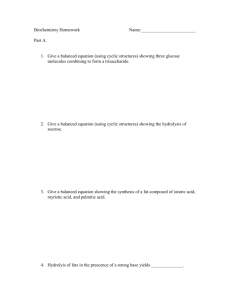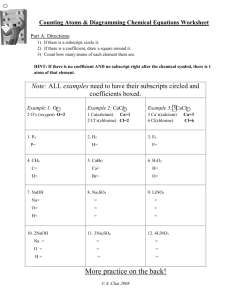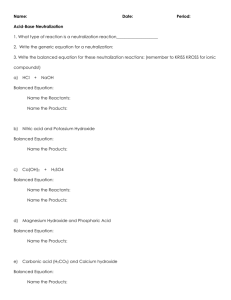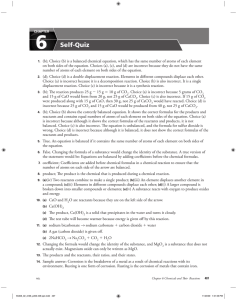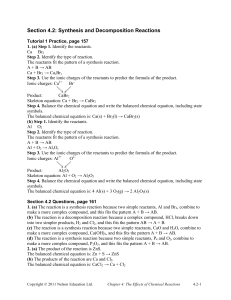6 sElF-QUIZ CHAPTER
advertisement
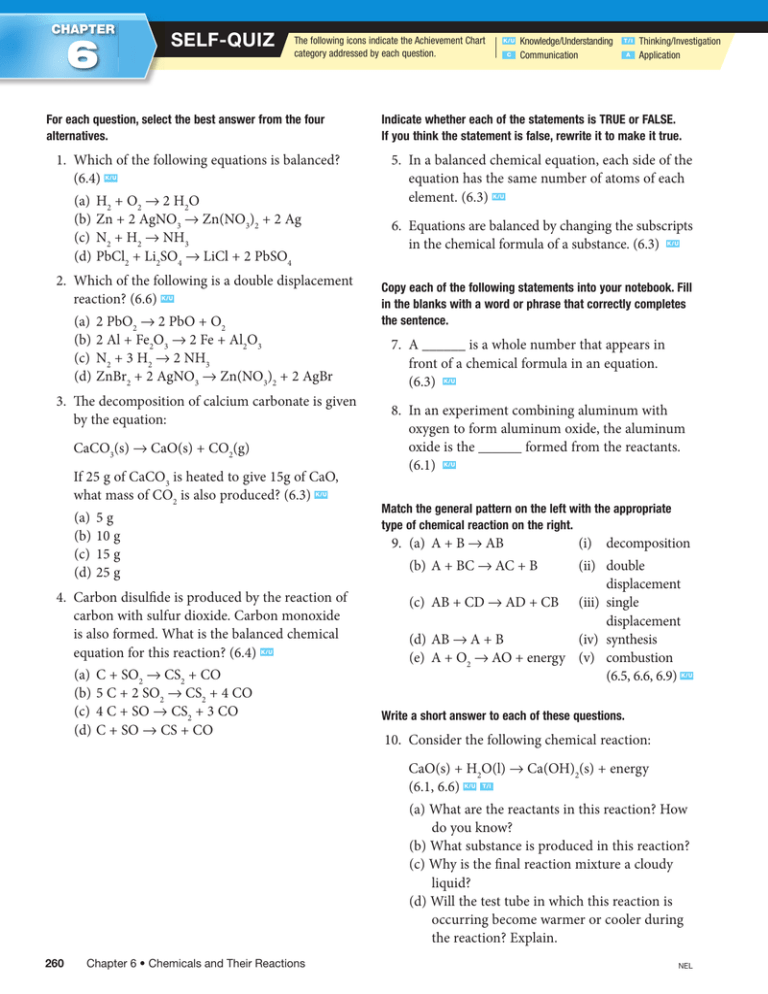
CHAPTER 6 sElF-QUIZ The following icons indicate the Achievement Chart category addressed by each question. For each question, select the best answer from the four alternatives. 1. Which of the following equations is balanced? (6.4) K/U (a) (b) (c) (d) H2 + O2 → 2 H2O Zn + 2 AgNO3 → Zn(NO3)2 + 2 Ag N2 + H2 → NH3 PbCl2 + Li2SO4 → LiCl + 2 PbSO4 C Knowledge/Understanding Communication T/I A Thinking/Investigation Application Indicate whether each of the statements is TRUE or FALSE. If you think the statement is false, rewrite it to make it true. 5. Inabalancedchemicalequation,eachsideofthe equation has the same number of atoms of each element. (6.3) K/U 6. Equations are balanced by changing the subscripts in the chemical formula of a substance. (6.3) K/U 2. Which of the following is a double displacement reaction? (6.6) K/U (a) (b) (c) (d) K/U 2 PbO2 → 2 PbO + O2 2 Al + Fe2O3 → 2 Fe + Al2O3 N2 + 3 H2 → 2 NH3 ZnBr2 + 2 AgNO3 → Zn(NO3)2 + 2 AgBr 3. The decomposition of calcium carbonate is given by the equation: CaCO3(s) → CaO(s) + CO2(g) If25gofCaCO3isheatedtogive15gofCaO, what mass of CO2 is also produced? (6.3) Copy each of the following statements into your notebook. Fill in the blanks with a word or phrase that correctly completes the sentence. 7. A ______ is a whole number that appears in front of a chemical formula in an equation. (6.3) K/U 8. In an experiment combining aluminum with oxygen to form aluminum oxide, the aluminum oxide is the ______ formed from the reactants. (6.1) K/U K/U (a) 5g (b) 10 g (c) 15g (d)25g Match the general pattern on the left with the appropriate type of chemical reaction on the right. 9. (a) A + B → AB (i) decomposition (b) A + BC → AC + B 4. Carbon disulfide is produced by the reaction of carbon with sulfur dioxide. Carbon monoxide is also formed. What is the balanced chemical equation for this reaction? (6.4) K/U (a) C + SO2 → CS2 + CO (b) 5C+2SO2 → CS2 + 4 CO (c) 4 C + SO → CS2 + 3 CO (d) C + SO → CS + CO (ii) double displacement (c) AB + CD → AD + CB (iii) single displacement (d) AB → A + B (iv) synthesis (e) A + O2 → AO + energy (v) combustion (6.5,6.6,6.9) K/U Write a short answer to each of these questions. 10. Consider the following chemical reaction: CaO(s) + H2O(l) → Ca(OH)2(s) + energy (6.1, 6.6) K/U T/I (a) What are the reactants in this reaction? How do you know? (b) What substance is produced in this reaction? (c) Why is the final reaction mixture a cloudy liquid? (d) Will the test tube in which this reaction is occurring become warmer or cooler during the reaction? Explain. 260 Chapter 6 • Chemicals and Their Reactions NEL 11. When baking soda (sodium hydrogen carbonate, NaHCO3(s)) is heated, it decomposes to form sodium carbonate, Na2CO3(s), carbon dioxide, and water. (6.1, 6.4) K/U C (a) Write the word equation for this reaction. (b) What evidence suggests that a chemical change is taking place? (c) Write a balanced chemical equation for this reaction. 12. The following unbalanced equation represents the formation of magnesium oxide from magnesium and oxygen. 19. The Eiffel Tower is an iron monument located in Paris,over150kmfromtheocean.Predicthow the rate of corrosion would change if the Eiffel Tower were located in a seaside town. (6.10) T/I 20. Your family is planning to grill hamburgers in the backyard, but it starts to rain. Someone suggests grilling in the garage instead. Explain why it would be risky to grill in the garage. (6.9) C 21. Give an example of how one chemical reaction can be beneficial in some applications and harmful in others. (6.1–6.10) A Mg + O2 → MgO Can this equation be balanced by changing the formula of the product to MgO2? Explain. (6.3, 6.4) K/U 13. List three pieces of information that can be obtained from a balanced chemical equation. (6.4) K/U 14. Compare corrosion and rusting, using specific examples. (6.10) K/U C 15. Asynthesisreactionisdefinedas“areactionin which two reactants combine to make a larger or morecomplexproduct.”(6.5) C (a) Write a definition of “synthesis reaction” in your own words. (b) Draw a diagram representing a typical synthesis reaction. 16. Describe one way you could protect a bicycle from corrosion. (6.10) T/I 17. (a) How does the name “hydrocarbon” give clues about the composition of hydrocarbons? (b) Give the names and formulas of three hydrocarbons. (6.9) 18. (a) Brieflydescribefivechemicalreactionsthat you may encounter in a typical day. A (b) Choose one of the reactions and identify the names of the products and reactants. (6.1–6.10) A NEL Chapter 6 Self-Quiz 261
